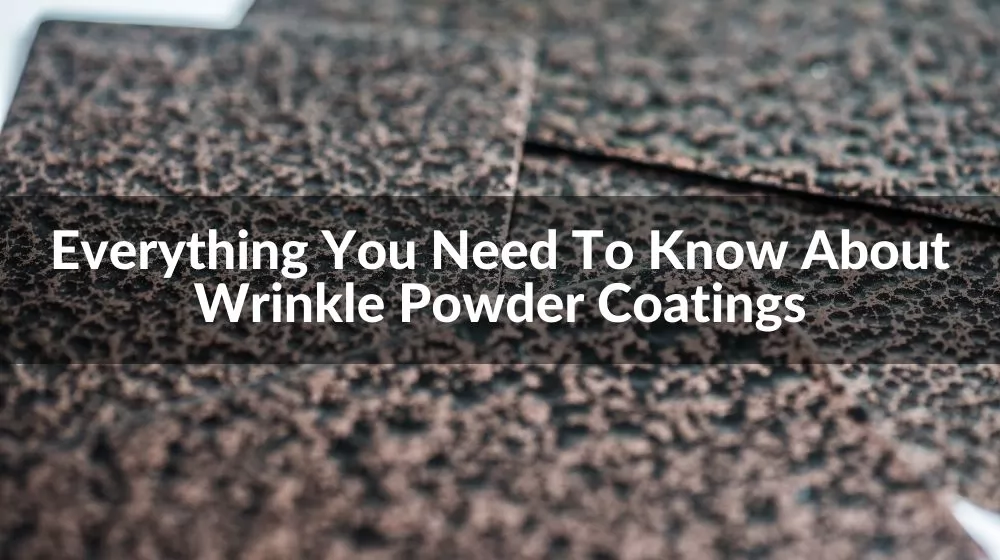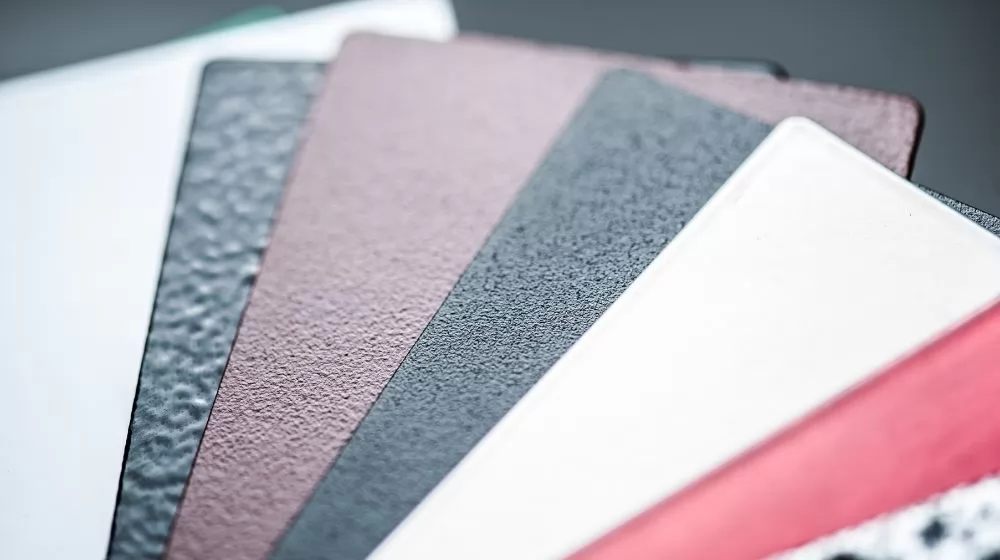
.png)

.png)
.png)


-
.png) 0086-757-85407388
0086-757-85407388 -

-
 terrychen@wintoly.com
terrychen@wintoly.com


.png)

.png)
.png)


.png)




Have you ever wondered why some furniture, automotive parts, or home decor items have such unique wrinkled textures on their surfaces? The answer may lie in the advanced coating technology known as wrinkled powder coating. Wrinkled powder coating not only provides products with an outstanding appearance but also offers durability and versatility, making it widely favored in various industrial and personal applications. This article will delve into wrinkled powder coating and uncover its unique charm.
Table of contents:
Wrinkled powder coatings are a special type of powder coating that is characterized by a wrinkled textured surface effect after curing. The paint usually consists of powder particles that are used to cover the surface of various objects, which are then heated at high temperatures to melt and solidify.
It is manufactured with special additives that give the coating a wrinkled effect during curing. Depending on the paint formulation and the way the coating is applied, these wrinkles can range from a fine, uniform texture to a larger, more pronounced texture. Besides wrinkle powder there are many other types of powder coatings such as smooth powder coating , sandy powder coating , antique powder coating , metallic powder coating , wood effect powder coating .

Wrinkle powder coating is a kind of coating with unique appearance effect and excellent performance. It cures to form a unique wrinkled texture, which makes the product more attractive, and has excellent durability and corrosion resistance, which can effectively protect the surface of objects from daily wear and tear and chemical attack. In addition, the wrinkled powder coating also has good high temperature stability and is suitable for applications in high temperature environments. Wrinkle powder coating is more environmentally friendly and contains no VOCs than traditional liquid paints. Its fast curing and uniform coverage make it widely used in various fields such as industrial manufacturing, automotive, and household products. In short, with its unique charm and multiple advantages, wrinkle powder coating has become an ideal choice for many product appearance and performance requirements.
Industrial product coating
Protection performance: Coating can effectively protect the surface of industrial products from oxidation, corrosion, abrasion and chemical erosion. It can extend the life of the product and reduce maintenance costs.
Aesthetic decoration: Painting can not only provide the protective properties required by the product, but also give the product a variety of colors and textures, increasing its appearance attractiveness and decorativeness.
Identification and identification: Coating can be used to identify and identify information on industrial products, such as product models, trademarks, warning signs, etc., to facilitate product tracking and identification.
Improve performance: Some coatings can endow industrial products with specific properties, such as anti-skid, heat insulation, conductivity, etc., to meet special needs.
Environmental protection, health and safety: Selecting environmentally friendly coatings and appropriate coating techniques can reduce the impact of the coating process on the environment and ensure the health and safety of operators.
Home Furnishings & Decor
Furniture coating: Furniture is the main component of household items. Coating technology can provide rich color choices and texture effects for the surface of furniture, making furniture a focal point in home decoration.
Wall painting: The wall is the largest part of home decoration. Painting can create different atmospheres and styles for the interior by choosing the right wall paint and color.
Lighting and hardware finishing: Lighting and hardware finishing can add to the durability and aesthetics of the product while also matching it to the interior decor.
Decoration and decoration painting: Home decorations and decorations often require a unique appearance, and painting technology can give these small items personalized colors and textures.
Painting of door and window frames: Door and window frames are often neglected parts of home decoration. Painting can improve their durability and coordinate with the overall home style.
Floor coating: Floor coating can give the floor better wear resistance and protection performance, and can also achieve different floor decoration effects.
Auto and Motorcycle Parts
Body painting: The body of automobiles and motorcycles is the most conspicuous part, and painting can provide it with rich color choices and gloss effects, increasing the appearance attractiveness of the vehicle.
Parts coating: various parts such as engine parts, chassis components, wheels and brake systems need to be coated to improve their corrosion resistance and wear resistance and prolong their service life.
Interior painting: The interior parts of automobiles and motorcycles, such as instrument panels, door panels, seats, etc., are also often painted to increase their texture and decorative effect.
Body marking and graphic painting: Painting technology can be used to apply vehicle branding, model logos and personalized graphics to make vehicles easier to identify and locate.
Anti-corrosion coating: On the exterior and chassis of automobiles and motorcycles, anti-corrosion coatings are used to protect vehicles from corrosion from harsh weather and road conditions.
High temperature coatings: High temperature components such as engines and exhaust systems require high temperature resistant coatings to maintain their stability and performance.

The powder coating finishing process is divided into three key stages:
Phase 1: Preprocessing
This stage is crucial for allowing the paint to develop to its full potential. All paints are porous and over time atmospheric conditions will penetrate through the coating to the metal. To prevent this, all substrates are chemically pre-treated to prevent corrosion and promote good adhesion.
Preprocessing details
The pretreatment of the powder coating finishing company uses a classic seven-stage soaking system, where the workpiece is loaded into a cage and then dipped in seven tanks.
1. Degreasing
All metal substrates must be cleaned before any other stages. Any remaining grease or lubricants from the manufacturing process are removed.
2. Water rinse
Between each chemical rinse, a water rinse is required to remove any chemical residue from the workpiece.
3. Acid etching (aluminum only)
The surface of the aluminum is deoxidized and any contaminants on the surface of the alloy are removed. Etching of aluminum is critical to prepare the substrate for the oxsilan stage.
4. Water rinse
5. Rinse with softened water
Before entering the tank, the water goes through a plant that removes all heavy metals and minerals. The conductivity of the water is kept at less than 200 microSiemens. This phase is critical to ensuring the continued integrity of the Oakland phase.
6. OXSILAN
The substrate is coated with silane and zirconium based polymers. It bonds with the substrate to provide excellent corrosion protection to the metal while promoting good adhesion.
7. Rinse with demineralized water
The conductivity of the water is kept at less than 30 microSiemens. Thorough rinsing of the metal ensures that no contaminants are deposited on the metal surface during the drying phase. Surface impurities may affect the adhesion and performance of the cured paint finish and no matter how good the previous stages are, unless the demineralization rinse is well maintained the paint will not be able to develop to its full potential.
8. Drying box
Hot air is circulated around the workpiece to dry the metal.
Phase 2: Coating
After pretreatment, the metal hangs on a conveyor belt line and enters a paint booth for coating. Compressed air is used to convey the powder from the fluidizing hopper to the spray gun. As the powder exits the gun, the particles become charged and thus attracted to the grounded metal piece. This creates an even coating around the workpiece.
Phase Three: Curing
After coating, the production line moves the workpieces to a tunnel oven for baking. After curing is complete, inspect the substrate for imperfections, paint thickness, color and gloss. If there are no problems, the product will be packed and ready to ship.
Comparison of advantages and disadvantages
the difference:
The surface of the smooth coating is smooth and flat, without obvious texture or unevenness.
It usually has a high gloss finish, which gives the surface a shiny appearance by reflecting light.
The surface of the texture coating has obvious texture and concave-convex feeling, which can form different texture effects, such as wrinkles, grains and so on.
It usually has a matte or semi-matte finish and does not reflect light like a smooth coating.
Smooth coating advantages:
Aesthetics: The appearance of smooth coating is smooth and consistent, and there are high aesthetic requirements for certain products and decoration styles, such as modern and minimalist styles.
Easy to clean: The smooth surface is easy to clean, and dust and stains are not easy to adhere to.
Smooth coating disadvantages:
Susceptible to scratches: Due to the smooth surface, smooth coatings are more susceptible to nicks and scratches, reducing their durability.
Easy to show fingerprints: Fingerprints are easy to leave after touching, and frequent cleaning and maintenance are required.
Texture Coating Advantages:
Unique Appearance: Textured coatings can impart a unique textured effect to a product, adding to its visual appeal and decorative appeal.
Hiding: Due to surface bumps, textured coatings are better at hiding imperfect surface imperfections.
Texture Coating Disadvantages:
Difficult to clean: Textured coatings are relatively difficult to clean due to the surface texture, where dirt and stains can accumulate.
Not suitable for some styles: The appearance of textured coatings is not suitable for all products and decor styles, and in some cases may appear too complicated or incongruous.
Choosing between a smooth or textured finish depends on the product's application, appearance needs and personal preference. Smooth coatings are suitable for occasions that require a smooth appearance, while textured coatings can bring unique visual effects and decoration to products, while covering imperfect surfaces to a certain extent. In terms of durability and cleaning, a smooth finish may be more convenient in some cases, while a textured finish may require more maintenance and attention. Therefore, it is very important to choose the appropriate coating type according to the actual needs and effects.

Custom effects and textures
In addition to the standard colors, the wrinkled powder coating can also be customized to meet individual needs. Customized effects and textures can be realized according to customers' requirements and design intentions. Some common custom effects and textures include:
Wrinkle Texture: A more prominent wrinkle effect, making the coating surface more textured.
Grainy Texture: Creates a small grainy texture on the surface of the coating, increasing its visual appeal.
Metal effect: By adding metal powder, the effect of metallic texture, such as metallic luster and reflection effect, can be realized.
High gloss: Increase the gloss effect of the coating, making the surface more bright.
Customized effects and textures make the wrinkle powder coating more flexible in decoration and design, and can meet the individual needs of different customers.
Crinkle Powder Coating in DIY Projects
Wrinkle powder coating is also a great option for individuals interested in doing a do-it-yourself coating project. In DIY projects, crinkle powder coating can be used to give homemade products a unique texture and look. With DIY crinkle powder coating, individuals can add a personalized look to their projects and have fun with the painting process. Note, however, that for complex or large-scale coating projects, it is best to seek professional painting services to ensure the quality and durability of the results.
Common Problems and Solutions
Coating peeling or flaking: May be caused by uneven coating application or insufficient surface preparation. The solution is to repaint and make sure the surface is clean and adequately pre-treated.
Scratches or Scratches: Avoid scratching the surface with sharp objects. For shallow scratches, you can try to wipe with a soft cloth or apply a professional coating repair agent.
Oxidation or Discoloration: Prolonged exposure to the outside environment may cause the coating to oxidize or discolor. Preventative measures include regular cleaning and avoiding exposure to harsh weather conditions.
Where to Buy Wrinkle Powder Coating?
Wrinkle powder coat is available at many paint and finishing material suppliers. You can go to your local paint store, building supplies market or online and search for wrinkle powder coating products. Choose reputable brands and suppliers to ensure quality and reliable products.
When shopping for a wrinkle powder coating, you should also pay attention to the suitability and specifications of the coating to meet your specific needs and project requirements. If a large number of coatings or special custom needs are required, it is recommended to contact the supplier for details. Wintol y can provide a wide range of colors and custom powder coatings to meet your specific needs.
Precautions:
Reputation and word of mouth: Selecting suppliers and manufacturers with good reputation and reputation can ensure the reliability of product quality and customer service. A supplier's reputation can be assessed by reviewing customer testimonials and consulting other users' experiences.
Product quality certification: ensure that the wrinkle powder coating products provided by the supplier have relevant quality certification, such as ISO 9001 quality management system certification, etc. These certifications prove that the manufacturer's production process and product quality are recognized and monitored.
Product Samples and Testing: Before purchasing large quantities of coatings, it is recommended to obtain samples for testing and evaluation. By testing samples, you can ensure that the performance and suitability of the coating meet your needs.
Prices and lead times: Compare prices and lead times for coatings with different suppliers. The lowest price is not always the best choice, you need to combine product quality and delivery time.
After-sales service: Ask if the supplier offers after-sales service, such as technical support and problem solving. You may encounter some problems during use, and timely after-sales service can help you solve the problems.
suggestion:
Seek quotes from multiple suppliers: Communicating with and obtaining quotes from multiple suppliers can help you get better prices and options.
Contact the Manufacturer Directly: For more information on product specifications, customization options, and lead times, contact the manufacturer directly.
Visit the production plant: If conditions permit, it is recommended to visit the production plant of the supplier or manufacturer. This allows a more intuitive understanding of its production process, quality control and equipment status.
Learn about after-sales support: Ask the supplier for details about after-sales support and services to ensure that you can get timely technical support and the ability to solve problems after purchase.
Customer Testimonials and References: Gathering as many testimonials and references as possible from other customers can help you better understand your supplier's reputation and product quality.
potential troubleshooting
Flaking or Peeling Coating: If the coating peels or flakes during application, it may be due to uneven application, insufficient surface preparation, or insufficient coating adhesion. Solutions include repainting and making sure the surface is clean and adequately pre-treated.
Coating Bubbles: Bubbles on the surface of the coating can be caused by moisture or contamination from the coating process. Precautions include ensuring a dry application environment, using clean spray equipment, and pre-treating the surface before painting.
Inconsistent coat color: Inconsistent coat color can be due to uneven paint mixing or problems during application. The solution is to stir the paint well to ensure an even color and to ensure an even application process.
Uneven coating surface: Uneven coating surfaces can be the result of uneven paint application or surface defects. Solutions include repainting and making sure the surface preparation and application process is correct.
Coating Deterioration or Discoloration: Prolonged exposure to harsh weather conditions may cause coating degradation or discoloration. Preventative measures include regular cleaning and avoiding prolonged exposure to strong sunlight.

How to solve common problems
Accurately control the construction thickness: During the construction process, use the appropriate coating thickness specifications and tools to ensure that the coating is evenly applied.
Adequate surface preparation: Before painting, ensure that the surface is sufficiently cleaned, degreased and descaled to ensure that the coating will adhere firmly to the surface.
Control Paint Viscosity: Follow paint manufacturer's recommendations to adjust paint viscosity for better application and coating uniformity.
Optimizing construction conditions: Coating is carried out under suitable humidity, temperature and wind speed conditions to ensure coating quality and adhesion.
Future trends and innovations
With the continuous development of technology and coating technology, there will be some future development trends and innovations in the wrinkle powder coating field:
Sustainability and environmental protection: The future trend will pay more attention to sustainability and environmental protection, and develop more environmentally friendly and low-volatility wrinkle powder coatings.
Functional coatings: More functional coatings will be developed, such as antibacterial coatings, anti-ultraviolet coatings, etc., to meet the special needs of different industries.
Customization and Personalization: As consumer demand for personalized products rises, more customized wrinkle powder coating options will be developed.
Digitalization and automation: The painting process will be more digitalized and automated to improve painting efficiency and quality.
New coating technology: New coating technologies may appear, such as nano-coating, light-responsive coating, etc., to expand the application field of coating.
Through the above introduction, I believe you have a more comprehensive understanding of this advanced coating technology and wrinkle powder coating. Whether you are a painting practitioner or a reader interested in painting technology, I hope this article can bring you valuable information and inspiration. If you encounter powder coating problems, please feel free to contact Wintoly!
1. What is powder coating?
2. What are the benefits of using powder coating?
3. What industries commonly utilize powder coating?
4. How do I choose a reliable powder coating supplier?
5. What types of powder coatings are available?
6. What is the typical minimum order quantity (MOQ) for powder coatings?
7. Can I request custom colors or formulations?
8. How do I ensure quality control when ordering powder coatings?
9. What are the typical curing requirements for powder coatings?
10. What are the payment terms typically offered by powder coating suppliers?
11. How can I request samples of powder coatings?
12. What should I consider when applying powder coatings?
When selecting a powder coating supplier, it’s essential to evaluate their product offerings, quality assurance processes, and customer service. Doing thorough research can help you find a supplier that meets your specific needs effectively.

 terrychen@wintoly.com
terrychen@wintoly.com
.png) 0086-757-85407388
0086-757-85407388
 6 Chaoyang Rd., National Demonstration Eco-industrialzone, Nanhai, Foshan,Guangdong,China
6 Chaoyang Rd., National Demonstration Eco-industrialzone, Nanhai, Foshan,Guangdong,China

.png)
